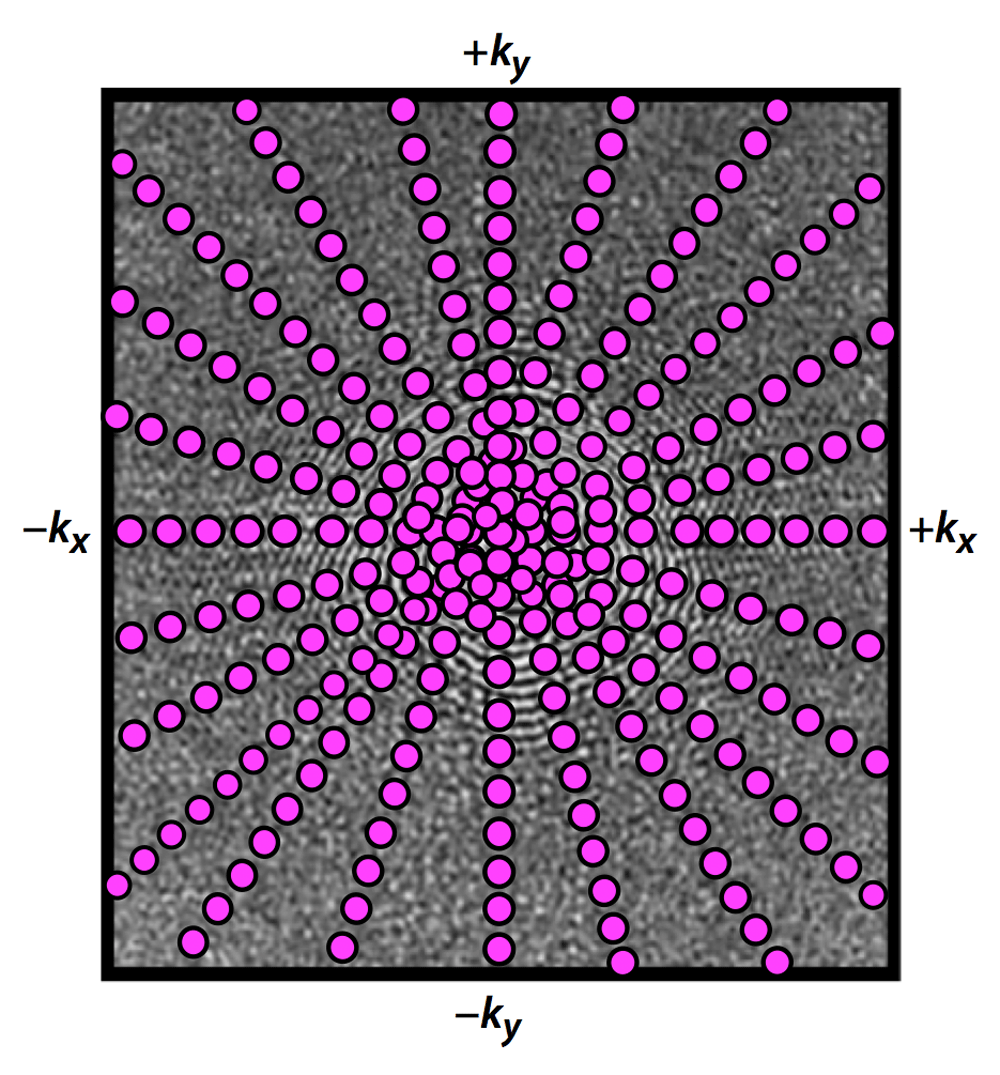|
Radial sampling of k-space data, one of the earliest methods for image reconstruction, was largely supplanted in the 1980's by the "spin-warp" technique that employed rectilinear (Cartesian) data acquisition. To this day, Cartesian methods remain dominant, but radial (and spiral) approaches are fast gaining ground.
|
 PROPELLER sequence sampling "blades" of data
PROPELLER sequence sampling "blades" of datain a rotating fashion around the center of k-space
 "Stack of Stars"
"Stack of Stars"
Advanced Discussion (show/hide)»
An additional advantage of radial acquisition is that it allows oversampling (512 or greater) in all directions without a time penalty. In conventional (Cartesian) imaging, oversampling is confined to a single direction (frequency-encode or readout). Because radial acquisition occurs in all directions, oversampling is not confined to a single axis. Accordingly, the field of view (FOV) can be smaller than the imaged object in radial sampling scheme without aliasing/wrap-around artifacts.
In addition to the gridding problem, another disadvantage of radial acquisition is uncertainty about the exact location of samples due to gradient delays and distortions. These gradient effects may shift the apparent positions of objects in different directions. To overcome this, a brief calibration scan is typically run prior to performing a radial sequence.
An fascinating mathematical question is how to choose the optimal angles for the radial spokes and in what order to acquire them. One elegant solution is to increment each spoke by approximately 111.25º, which is 180º divided by the golden ratio (Φ = ½(√5+1) ≈ 1.62) from classical geometry. The golden ratio has a variety of interesting properties that explains its presence in nature, including determining the shapes of sea shells and distribution of leaves on plant stems. When the golden angle is selected for a radial acquisition, each successive spoke divides the largest remaining angular gap in half. As the process continues a uniform sampling of k-space is approached in the limit. Symmetrical distribution of spokes occurs when the number of spokes matches one of the Fibonacci numbers (5, 8, 13, 21, 34, 55, etc). A promising application of this method is known as GRASP (Golden-angle RAdial Sparse Parallel) MRI.
Block KT, Chandarana H, Milla S, et al. Toward routine clinical use of radial stack-of-stars 3D gradient-echo sequences for reducing motion sensitivity. J Korean Soc Magn Reson Med 2014; 18:87-106. [DOI LINK]
Chandarana H, Block TK, Rosenkrantz AB, et al. Free-breathing radial 3D fat-suppressed T1-weighted gradient echo sequence: a viable alternative for contrast-enhanced liver imaging in patients unable to suspend respiration. Invest Radiol. 2011;46:648–653. (StarVIBE and Stack of Stars implementation for liver imaging).
Feng L, Grimm R, Block KT, et al. Golden-angle radial sparse parallel MRI: combination of compressed sensing, parallel imaging, and golden-angle radial sampling for fast and flexible dynamic volumetric MRI. Magn Reson Med 2014; 72:707-717. (The "GRASP" technique)
Lauterbur PC. Image formation by induced local interactions: examples employing nuclear magnetic resonance. Nature 1973; 242:190-1. (Historic paper where radial reconstruction was used to produce the world's first MR image).
Pipe JG. Motion correction with PROPELLER MRI: application to head motion and free-breathing cardiac imaging. Magn Reson Med 1999; 42:963-969.
What about wrap-around artifacts on radial or spiral imaging? it seems like they should always be present because phase-encode goes in every direction.
How does PROPELLER reduce motion artifacts?


